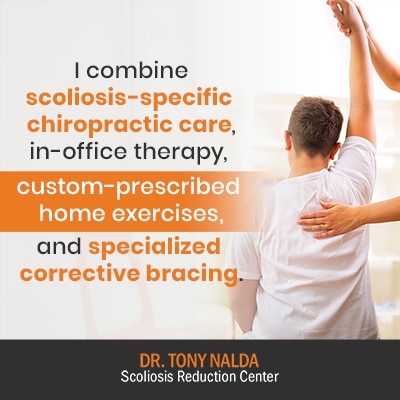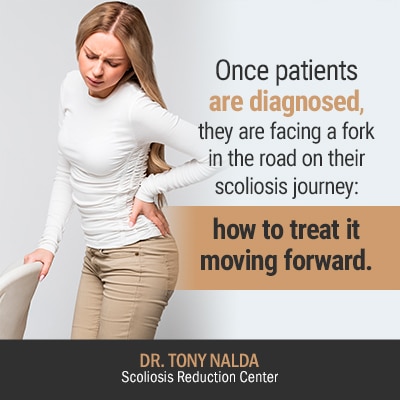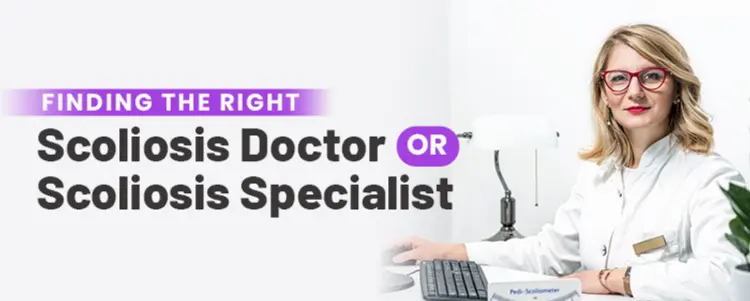There are two main scoliosis treatment approaches: conservative and traditional. I highly encourage all patients to do their own due diligence in researching which approach suits their treatment expectations and lifestyle. As the nature of scoliosis necessitates highly-customized treatment plans, a doctor or chiropractor who specializes in scoliosis will have the training and experience needed to comprehensively read a scoliosis X-ray and craft an equally-comprehensive treatment plan.
As different treatment approaches offer different potential outcomes, choosing the best scoliosis doctor involves finding one whose treatment approach is aligned with the patient’s expectations. As such a complex progressive condition, a doctor or chiropractor who specializes in scoliosis is key.
Before we move on to the specifics of how to find the best scoliosis doctor, let’s first talk generally about scoliosis for a clear understanding of how the nature of the condition necessitates such a highly-customized treatment approach.
The Complexities of Scoliosis
If a person is diagnosed with scoliosis, this means they have an abnormal sideways spinal curvature that rotates and has a minimum Cobb angle of 10 degrees; Cobb angle is a measurement obtained via X-ray that tells me how far out of alignment a scoliotic spine is and places a condition on its severity scale of mild, moderate, severe, or very severe.
Scoliosis is often described as ‘complex’ or ‘mysterious’, and one of the reasons for this is that no two cases of scoliosis are the same. Every treatment plan has to be fully customized to address important patient and condition characteristics, such as condition severity:
- Mild scoliosis: Cobb angle measurement of between 10 and 25 degrees
- Moderate scoliosis: Cobb angle measurement of between 25 and 40 degrees
- Severe scoliosis: Cobb angle measurement of 40+ degrees
- Very-severe scoliosis: Cobb angle measurement of 80+ degrees
As a progressive condition, the nature of scoliosis is to worsen over time, especially if left untreated, or not treated proactively.
While we can’t, with 100-percent accuracy, determine what a patient’s progressive rate will be, we do know that growth is the number-one trigger for progression, so part of designing a comprehensive treatment plan has to include staying ahead of each patient’s progressive line.
In addition to having a wide range of severity levels associated with different symptoms, there are also different types of scoliosis a person can develop.
The majority of known scoliosis cases, 80 percent, are classified as ‘idiopathic’, meaning a clear single-known cause has not been determined; the condition is instead considered to be ‘multifactorial’, meaning caused by multiple variables that can vary from one patient to the next.
The fact that we don’t yet fully understand scoliosis causation is why it’s so often described as a ‘mysterious’ condition.
The remaining 20 percent of scoliosis cases are associated with known causes: neuromuscular, congenital, degenerative, and traumatic. Each different type of scoliosis necessitates its own unique treatment approach as the condition’s underlying cause drives the treatment approach moving forward.
The condition’s most prevalent form is adolescent idiopathic scoliosis (AIS), diagnosed in individuals between the ages of 10 and 18.
As you can see, just from the wide range of Cobb angle degrees that determine condition severity, plus the condition’s progressive nature and different types that can develop, scoliosis is, indeed, a complex condition that necessitates an equally-comprehensive treatment approach.
As mentioned, there are two main treatment approaches for patients to choose between: conservative and traditional. Let’s explore the differences.
Scoliosis Treatment Approaches: Conservative vs. Traditional
It’s important to understand the differences between a conservative and traditional approach to scoliosis treatment because each approach has a different end goal, and that end goal is what guides the design of treatment plans and produces different outcomes.
You have to ensure that the doctor or chiropractor you’ve selected to treat your scoliosis is using an approach that can deliver the type of results you are looking for, and part of that is understanding important differences between the two main treatment approaches.
Conservative Treatment Approach
Here at the Scoliosis Reduction Center®, I offer patients a chiropractic-centered conservative approach that works to improve the spine’s overall health and function.
The ultimate goal of this approach is correction and stabilization; first and foremost, as scoliosis is a structural condition, I want to impact it on a structural level in the form of a curvature reduction.
I also strongly believe in the importance of proactive treatment. A conservative approach is governed by the belief that progression can be managed effectively, and while no treatment results are guaranteed, early detection and proactive treatment started as close to the time of diagnosis as possible is associated with higher chances of treatment success.
Working towards a curvature reduction while a curve is small is a simpler process as the spine is more flexible, the body has had less time to adjust to its presence, and significant progression has not yet occurred.
After all, there is no harm in reducing a mild curve, but there is potential harm in allowing a small curve to progress unimpeded before applying treatment.
Here at the Center, my conservative approach is integrative as I believe the application of multiple treatment disciplines best addresses the nature of scoliosis and offers the best prognosis.

I combine scoliosis-specific chiropractic care, in-office therapy, custom-prescribed home exercises, and specialized corrective bracing.
As a scoliosis chiropractor trained in multiple treatment modalities, I can apportion each discipline accordingly to address the specifics of each patient, their condition, and how their spine is responding to treatment.
A fully customized approach is best because the nature of scoliosis necessitates it. Particularly in cases of AIS, proactive treatment that addresses the condition’s structural nature is important because as this age group is facing the rapid and unpredictable growth spurts of puberty, they are at risk for rapid-phase progression.
By starting proactive treatment early on, a patient’s progressive line can be monitored and responded to in order to prevent further progression and spare patients the hardships associated with increasing condition severity, which can result in the need for more invasive treatment down the road.
Now that we have explored the conservative chiropractic-centered treatment approach I offer patients here at the Scoliosis Reduction Center®, let’s take a look at the other main treatment approach that offers patients a different outcome: traditional.
Traditional Treatment Approach
The traditional treatment approach has been in place for many years, but its fundamentals have remained unchanged over those years, despite the fact that our understanding of the condition has evolved.
Along the traditional route of treatment, most often, this path involves a general practitioner or chiropractor noticing indicators for scoliosis and referring patients to orthopedic surgeons.
While every case is different, this generally involves the recommendation to monitor mild cases for progression, but in the mild stage, treatment is not applied. It’s generally not until a patient has progressed into the moderate stage that treatment is started, in the form of scoliosis bracing.
Traditional bracing, like the traditional approach as a whole, has slowing/stopping progression as its end goal; this is different from braces that are designed to be corrective, like the modern ScoliBrace.
If bracing is unsuccessful in stopping a patient from progressing, once that curvature has progressed to over 40 degrees, it has crossed that surgical-level threshold and spinal fusion is commonly recommended as the best option.
When it comes to scoliosis treatment vs scoliosis surgery, the treatment I offer at the Center focuses on correction, while surgery focuses on stopping progression: two very different things.
In spinal fusion, multiple different vertebrae (bones of the spine) are fused together to form one solid bone, and the spine is attached to rods that hold it in place throughout the healing process. This is done to eliminate movement in the affected area, but there are no guarantees that progression will be permanently stopped, and this can also mean a significant loss in spinal flexibility.
While spinal fusion can be successful at preventing future progression, the way it is achieved, by fusing the spine into a corrective position, can come at the price of the spine’s overall health and function.
For patients experiencing a noticeable decrease in spinal flexibility post-surgery, this can impact their overall quality of life, especially if they are no longer able to participate in the activities they love.
In addition, as is the case with most surgical procedures, there are many potential side effects and risks of complications associated with spinal fusion such as nerve damage, infection, pain at the fusion site, hardware failure, and more.
Stopping progression is the ultimate goal of spinal fusion and the traditional scoliosis treatment approach as a whole, and this is not the same as what I offer patients at the Center: treatment that’s proactive and integrative with the end goals of correction and stabilization.
Now that we have explored the two main treatment approaches and their different potential outcomes, I’d like to suggest some helpful questions to ask potential scoliosis treatment providers as I feel they can lead to finding the right scoliosis doctor or scoliosis specialist.
Four Key Questions to Ask Potential Scoliosis Treatment Providers
When someone is diagnosed with scoliosis, there is a lot of important information to take in. Patients often have a lot of questions about how they got the condition, how bad it can get, how painful it can be, and how it will affect their life generally.

Once patients are diagnosed, they are facing a fork in the road on their scoliosis journey: how to treat it moving forward.
While scoliosis is progressive, that doesn’t mean it can’t be managed effectively with an appropriate course of treatment, and finding the right scoliosis doctor/chiropractor and corresponding treatment approach can have life-long consequences in terms of spinal health and function.
I encourage all patients to do their own due diligence in making sure they are fully aware of all treatment options available to them, as well as understanding the different potential outcomes they offer, particularly in terms of quality of life.
Following are four helpful questions to ask doctors and chiropractors in your search for the right treatment-provider:
- “Is Scoliosis Your Specialty?”
Perhaps the first, and most important, question to ask of a medical professional is what their focus is.
If they are a general practitioner or general chiropractor, this means they are not trained and experienced in the complexities of assessing and treating scoliosis.
Certain aspects of treatment, such as how to comprehensively read a scoliosis X-ray (this involves a lot of precise measurements), as well as crafting effective treatment plans for a truly customized approach, are simply beyond the scope of general care and require scoliosis-specific treatment providers.
In addition to being a CLEAR-certified scoliosis chiropractor, I am also certified in ISICO, SEAS, Gomez orthotics, chiropractic biophysics, the use of the ultra-corrective ScoliBrace, and Digital-Motion X-ray.
When these different treatment disciplines, modalities, certifications, and training are combined, it means that every aspect of the condition is understood, and this leads to a more well-rounded, integrative, and comprehensive treatment approach; this is something I think every patient deserves.
- “Have You Seen Cases Like Mine Before?”
This question is one I wish was asked more frequently. While every case is unique, if your doctor or chiropractor hasn’t seen a case like yours before, they might lack the expertise to treat it effectively.
If they answer ‘yes’, then it’s time to ask the next question.
- “What Types of Treatment Results Have you Achieved And How?”
This is important because as a potential patient, you have every right to know how other cases, similar to yours, have responded to the doctor’s treatment.
I spend a lot of time talking with potential patients and their families at the beginning of their scoliosis journeys, and part of that is sharing results I have achieved here at the Scoliosis Reduction Center®, and these results speak for themselves.
In fact, our YouTube channel is dedicated to just that: sharing patient success stories and informational videos so patients know exactly what to expect from my care.
If a doctor or chiropractor doesn’t have similar patient stories and results to share, chances are, they might not have the experience necessary to help you reach your desired treatment goals.
By enquiring into how treatment results are achieved, you will learn what disciplines are involved in the treatment process and whether they take a single-minded approach or integrate different treatment disciplines for a truly customized approach.
- “What is the End Goal of Your Treatment?”
This is a good question to ask because, as you likely recall, the end goal of treatment informs the design of treatment plans and shapes patients’ experiences of life with the condition moving forward.
In addition, this is also a good question to ask because providers need to set realistic expectations for treatment. No results can be guaranteed, but ensuring your expectations are aligned with the realities of potential treatment outcomes is important.
If the main end goal of treatment is to stop progression, as in the traditional approach, this is often achieved through spinal fusion, but this doesn’t always give patients the best possible quality of life post-surgery.
Even if the spine is straighter and progression has stopped, if that comes at the cost of the spine’s flexibility and function, it can cause mobility limitations.
If the main end goal of treatment is correction and stabilization, as in the conservative approach, this means addressing the underlying structural nature of scoliosis by working towards a curvature reduction and increasing core strength to help stabilize the spine.
While I value large corrections, here at the Scoliosis Reduction Center®, I want to deliver corrective results through treatment disciplines that work to improve the spine’s natural biomechanics, curvatures, and alignment so the spine’s strength, function, and overall health are preserved.
By asking these questions, you are ensuring a potential doctor or chiropractor has the scoliosis-specific training and experience to craft a customized and effective treatment plan: one that prioritizes the spine’s overall health and function for the best possible quality of life.
Conclusion
When it comes to finding the right scoliosis doctor for children and the right scoliosis doctor for adults, empowerment through information is key.
Patients, and their families, need to advocate for themselves by doing research on the different treatment approaches available beforehand; that way, they know the questions to ask and what the answers reveal about the likelihood of treatment efficacy.
Patients should also ensure that their treatment expectations are aligned with the realities of what their chosen treatment provider can deliver.
While scoliosis is progressive, it can be treated in such a way that the spine’s health and function are improved upon, and while early detection is beneficial in terms of potential treatment success, these benefits are only available to patients who are being treated by a doctor of chiropractor that values proactive treatment; those under traditional care are likely to experience a more single-minded approach to treatment that follows the path of monitoring, bracing, and surgery.
When it comes to the choice between a surgical or chiropractic-centered approach to treating scoliosis, I caution patients to make sure they know the risks associated with spinal fusion, as well as how it can impact quality of life in terms of spinal function, health, and flexibility.
Here at the Scoliosis Reduction Center®, I believe in working towards condition improvement early on so a mild condition will stay mild and patients won’t have to experience the challenges of increasing condition severity that might lead to the need for more invasive forms of treatment down the road.
Here at the Center, combining scoliosis-specific chiropractic care, in-office therapy, custom-prescribed home exercises, and specialized corrective bracing impacts scoliosis on a structural level and increases core strength so the spine is better supported and stabilized naturally.





